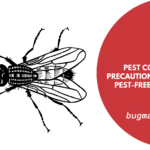
Pests can be a nuisance, infiltrating our homes and businesses, causing damage and spreading diseases. To combat these unwanted invaders effectively, pest control measures are essential.
However, it’s crucial to prioritize safety while dealing with pests. In this article, we will delve into the top safety precautions to consider when implementing pest control strategies.
Understanding the Importance of Pest Control Safety
Pest control plays a pivotal role in maintaining a clean and healthy living or working environment. Nevertheless, the chemicals and methods employed can pose risks to humans, pets, and the ecosystem. By adhering to safety guidelines, you can ensure effective pest management without compromising well-being.
Precautions Before Pest Control Application
Before initiating any pest control measures, there are several precautions you should take:
Identify the Pest
Different pests require different control methods. Identifying the specific pest infestation helps in selecting the most appropriate treatment, and minimizing unnecessary chemical exposure.
Research the Treatment
Conduct thorough research on the chosen pest control method. Understand the chemicals involved and their potential risks, ensuring you’re equipped with the necessary knowledge to handle them safely.
Prepare the Area
Clear the area of food, utensils, and items that may come into contact with the pesticides. Cover water sources, aquariums, and pet bowls to prevent contamination.
During Pest Control Application
While applying pest control measures, follow these precautions:
Wear Appropriate Gear
Don protective clothing, including gloves, goggles, and a mask, to shield your skin, eyes, and respiratory system from exposure to chemicals.
Ventilate the Area
Ensure proper ventilation by opening windows and doors. This helps in dissipating the fumes and preventing indoor air pollution.
Keep Children and Pets Away
Restrict access to the treated area for children and pets. They are more vulnerable to the effects of pesticides due to their smaller size and developing immune systems.
After Pest Control Application
Post-treatment precautions are equally vital:
Wait Before Re-entering
Allow ample time for the treated area to dry and the fumes to disperse before re-entering. This prevents direct contact with residual chemicals.
Clean Thoroughly
After treatment, clean surfaces thoroughly to remove any residue. This reduces the likelihood of accidental ingestion or skin contact.
Dispose of Containers Properly
Dispose of pesticide containers, unused products, and contaminated items responsibly. Follow local disposal guidelines to prevent environmental pollution.
Natural and Non-Toxic Alternatives
For those concerned about chemical exposure, natural and non-toxic pest control alternatives are available:
Integrated Pest Management (IPM)
IPM focuses on using multiple techniques to control pests while minimizing chemical use. This approach includes habitat modification, biological control, and targeted pesticide application.
DIY Remedies
Explore DIY solutions such as homemade repellents, traps, and beneficial insect release. These methods can effectively manage pests without resorting to harsh chemicals.
FAQs about Pest Control Safety
Are natural pest control methods completely safe?
Natural pest control methods are generally safer than chemical alternatives. However, it’s important to follow proper usage instructions to avoid any risks.
Can I apply pest control methods myself?
Yes, you can. Just ensure you research thoroughly and follow safety guidelines to protect yourself and others.
How often should pest control measures be applied?
The frequency depends on the severity of the infestation. Consulting a professional can help determine the appropriate schedule.
Are pest control chemicals harmful to pets?
Yes, some pest control chemicals can be harmful to pets. Keep them away from treated areas until it’s safe to re-enter.
Where can I find more information about safe pest control?
You can find more information from reputable pest control agencies, government websites, and environmental organizations.
Conclusion
Prioritizing safety during pest control activities is essential for safeguarding health and the environment. By following proper precautions before, during, and after application, you can effectively manage pest infestations while minimizing risks. Remember, a pest-free environment doesn’t have to come at the expense of safety.
